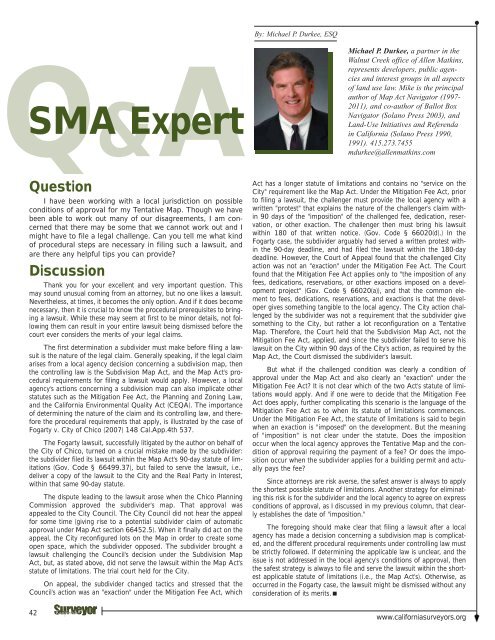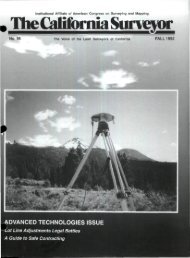Sacramento Surveyors Visit the NGS Airborne Gravimeter - CLSA
Sacramento Surveyors Visit the NGS Airborne Gravimeter - CLSA
Sacramento Surveyors Visit the NGS Airborne Gravimeter - CLSA
You also want an ePaper? Increase the reach of your titles
YUMPU automatically turns print PDFs into web optimized ePapers that Google loves.
By: Michael P. Durkee, ESQ<br />
Q&A<br />
SMA Expert<br />
Question<br />
I have been working with a local jurisdiction on possible<br />
conditions of approval for my Tentative Map. Though we have<br />
been able to work out many of our disagreements, I am concerned<br />
that <strong>the</strong>re may be some that we cannot work out and I<br />
might have to file a legal challenge. Can you tell me what kind<br />
of procedural steps are necessary in filing such a lawsuit, and<br />
are <strong>the</strong>re any helpful tips you can provide?<br />
Discussion<br />
Thank you for your excellent and very important question. This<br />
may sound unusual coming from an attorney, but no one likes a lawsuit.<br />
Never<strong>the</strong>less, at times, it becomes <strong>the</strong> only option. And if it does become<br />
necessary, <strong>the</strong>n it is crucial to know <strong>the</strong> procedural prerequisites to bringing<br />
a lawsuit. While <strong>the</strong>se may seem at first to be minor details, not following<br />
<strong>the</strong>m can result in your entire lawsuit being dismissed before <strong>the</strong><br />
court ever considers <strong>the</strong> merits of your legal claims.<br />
The first determination a subdivider must make before filing a lawsuit<br />
is <strong>the</strong> nature of <strong>the</strong> legal claim. Generally speaking, if <strong>the</strong> legal claim<br />
arises from a local agency decision concerning a subdivision map, <strong>the</strong>n<br />
<strong>the</strong> controlling law is <strong>the</strong> Subdivision Map Act, and <strong>the</strong> Map Act's procedural<br />
requirements for filing a lawsuit would apply. However, a local<br />
agency's actions concerning a subdivision map can also implicate o<strong>the</strong>r<br />
statutes such as <strong>the</strong> Mitigation Fee Act, <strong>the</strong> Planning and Zoning Law,<br />
and <strong>the</strong> California Environmental Quality Act (CEQA). The importance<br />
of determining <strong>the</strong> nature of <strong>the</strong> claim and its controlling law, and <strong>the</strong>refore<br />
<strong>the</strong> procedural requirements that apply, is illustrated by <strong>the</strong> case of<br />
Fogarty v. City of Chico (2007) 148 Cal.App.4th 537.<br />
The Fogarty lawsuit, successfully litigated by <strong>the</strong> author on behalf of<br />
<strong>the</strong> City of Chico, turned on a crucial mistake made by <strong>the</strong> subdivider:<br />
<strong>the</strong> subdivider filed its lawsuit within <strong>the</strong> Map Act's 90-day statute of limitations<br />
(Gov. Code § 66499.37), but failed to serve <strong>the</strong> lawsuit, i.e.,<br />
deliver a copy of <strong>the</strong> lawsuit to <strong>the</strong> City and <strong>the</strong> Real Party in Interest,<br />
within that same 90-day statute.<br />
The dispute leading to <strong>the</strong> lawsuit arose when <strong>the</strong> Chico Planning<br />
Commission approved <strong>the</strong> subdivider's map. That approval was<br />
appealed to <strong>the</strong> City Council. The City Council did not hear <strong>the</strong> appeal<br />
for some time (giving rise to a potential subdivider claim of automatic<br />
approval under Map Act section 66452.5). When it finally did act on <strong>the</strong><br />
appeal, <strong>the</strong> City reconfigured lots on <strong>the</strong> Map in order to create some<br />
open space, which <strong>the</strong> subdivider opposed. The subdivider brought a<br />
lawsuit challenging <strong>the</strong> Council's decision under <strong>the</strong> Subdivision Map<br />
Act, but, as stated above, did not serve <strong>the</strong> lawsuit within <strong>the</strong> Map Act's<br />
statute of limitations. The trial court held for <strong>the</strong> City.<br />
On appeal, <strong>the</strong> subdivider changed tactics and stressed that <strong>the</strong><br />
Council's action was an "exaction" under <strong>the</strong> Mitigation Fee Act, which<br />
42<br />
Michael P. Durkee, a partner in <strong>the</strong><br />
Walnut Creek office of Allen Matkins,<br />
represents developers, public agencies<br />
and interest groups in all aspects<br />
of land use law. Mike is <strong>the</strong> principal<br />
author of Map Act Navigator (1997-<br />
2011), and co-author of Ballot Box<br />
Navigator (Solano Press 2003), and<br />
Land-Use Initiatives and Referenda<br />
in California (Solano Press 1990,<br />
1991). 415.273.7455<br />
mdurkee@allenmatkins.com<br />
Act has a longer statute of limitations and contains no "service on <strong>the</strong><br />
City" requirement like <strong>the</strong> Map Act. Under <strong>the</strong> Mitigation Fee Act, prior<br />
to filing a lawsuit, <strong>the</strong> challenger must provide <strong>the</strong> local agency with a<br />
written "protest" that explains <strong>the</strong> nature of <strong>the</strong> challenger's claim within<br />
90 days of <strong>the</strong> "imposition" of <strong>the</strong> challenged fee, dedication, reservation,<br />
or o<strong>the</strong>r exaction. The challenger <strong>the</strong>n must bring his lawsuit<br />
within 180 of that written notice. (Gov. Code § 66020(d).) In <strong>the</strong><br />
Fogarty case, <strong>the</strong> subdivider arguably had served a written protest within<br />
<strong>the</strong> 90-day deadline, and had filed <strong>the</strong> lawsuit within <strong>the</strong> 180-day<br />
deadline. However, <strong>the</strong> Court of Appeal found that <strong>the</strong> challenged City<br />
action was not an "exaction" under <strong>the</strong> Mitigation Fee Act. The Court<br />
found that <strong>the</strong> Mitigation Fee Act applies only to "<strong>the</strong> imposition of any<br />
fees, dedications, reservations, or o<strong>the</strong>r exactions imposed on a development<br />
project" (Gov. Code § 66020(a)), and that <strong>the</strong> common element<br />
to fees, dedications, reservations, and exactions is that <strong>the</strong> developer<br />
gives something tangible to <strong>the</strong> local agency. The City action challenged<br />
by <strong>the</strong> subdivider was not a requirement that <strong>the</strong> subdivider give<br />
something to <strong>the</strong> City, but ra<strong>the</strong>r a lot reconfiguration on a Tentative<br />
Map. Therefore, <strong>the</strong> Court held that <strong>the</strong> Subdivision Map Act, not <strong>the</strong><br />
Mitigation Fee Act, applied, and since <strong>the</strong> subdivider failed to serve his<br />
lawsuit on <strong>the</strong> City within 90 days of <strong>the</strong> City's action, as required by <strong>the</strong><br />
Map Act, <strong>the</strong> Court dismissed <strong>the</strong> subdivider's lawsuit.<br />
But what if <strong>the</strong> challenged condition was clearly a condition of<br />
approval under <strong>the</strong> Map Act and also clearly an "exaction" under <strong>the</strong><br />
Mitigation Fee Act? It is not clear which of <strong>the</strong> two Act's statute of limitations<br />
would apply. And if one were to decide that <strong>the</strong> Mitigation Fee<br />
Act does apply, fur<strong>the</strong>r complicating this scenario is <strong>the</strong> language of <strong>the</strong><br />
Mitigation Fee Act as to when its statute of limitations commences.<br />
Under <strong>the</strong> Mitigation Fee Act, <strong>the</strong> statute of limitations is said to begin<br />
when an exaction is "imposed" on <strong>the</strong> development. But <strong>the</strong> meaning<br />
of "imposition" is not clear under <strong>the</strong> statute. Does <strong>the</strong> imposition<br />
occur when <strong>the</strong> local agency approves <strong>the</strong> Tentative Map and <strong>the</strong> condition<br />
of approval requiring <strong>the</strong> payment of a fee? Or does <strong>the</strong> imposition<br />
occur when <strong>the</strong> subdivider applies for a building permit and actually<br />
pays <strong>the</strong> fee?<br />
Since attorneys are risk averse, <strong>the</strong> safest answer is always to apply<br />
<strong>the</strong> shortest possible statute of limitations. Ano<strong>the</strong>r strategy for eliminating<br />
this risk is for <strong>the</strong> subdivider and <strong>the</strong> local agency to agree on express<br />
conditions of approval, as I discussed in my previous column, that clearly<br />
establishes <strong>the</strong> date of "imposition."<br />
The foregoing should make clear that filing a lawsuit after a local<br />
agency has made a decision concerning a subdivision map is complicated,<br />
and <strong>the</strong> different procedural requirements under controlling law must<br />
be strictly followed. If determining <strong>the</strong> applicable law is unclear, and <strong>the</strong><br />
issue is not addressed in <strong>the</strong> local agency's conditions of approval, <strong>the</strong>n<br />
<strong>the</strong> safest strategy is always to file and serve <strong>the</strong> lawsuit within <strong>the</strong> shortest<br />
applicable statute of limitations (i.e., <strong>the</strong> Map Act's). O<strong>the</strong>rwise, as<br />
occurred in <strong>the</strong> Fogarty case, <strong>the</strong> lawsuit might be dismissed without any<br />
consideration of its merits.<br />
www.californiasurveyors.org
















